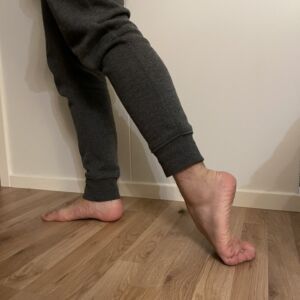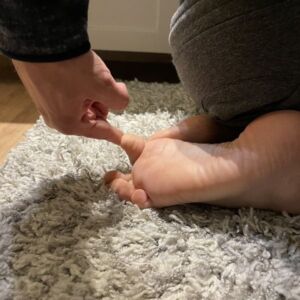How To Stretch Extensor Hallucis Longus – 3 Effective Stretches and PNF Stretching Technique
Extensor hallucis longus (EHL) is a muscle located on the front of your lower leg. This muscle is relatively thin and has a role in extending the big toe. Additionally, EHL is helping dorsiflexing your ankle which means to pull your ankle up, towards your body.
EHL muscle originates from the medial surface of the Fibula and attaches to the distal phalanx of the great toe. It’s surrounded by muscles like m. tibialis anterior and m. extensor digitorum longus.
Let’s move on to the effective stretches for extensor hallucis longus.
Related articles: How to stretch extensor digitorum longus, Stretches for extensor digitorum brevis
3 Best Stretches for Extensor Hallucis Longus
Standing EHL Stretch
While standing, place your foot and big toe on the ground. Push with your body towards, so you increase the flexion of your big toe and foot as well. That way you will stretch EHL muscle. Find the pleasant stretching intensity (avoid burning sensation in your muscle) and hold for 30s.
Seated EHL Stretch
While sitting with crossed legs, use your thumb and point finger to passively stretch your big toe downward, into flexion. Add passive ankle plantar flexion to increase the extensor hallucis longus stretch even more. Hold for 30s.
Kneeling EHL Stretch
Sit on your feet. Your feet are in plantar flexion which make this starting position very effective when stretching EHL muscle. Use your fingers to lift your big toe from the ground. Hold for 30s.
How to Find Extensor Hallucis Longus?
Lift your big toe up and you will see the prominent tendon of EHL muscle. Palpate this tendon and just follow the EHL muscle longitudinally. Since EHL muscle is easy to confuse with the extensor digitorum longus, keep in mind that EHL muscle is more medially located.
Here is the picture of the extensor hallucis longus muscle.
PNF Stretching Technique for Extensor Hallucis Longus
There are two PNF techniques that you can use to relax/stretch extensor hallucis longus.
The first one is the contract-relax technique. Here is how to perform this PNF technique.
- Sit on a chair
- Cross your legs
- Grab a big toe with your thumb and point finger
- Gently pull your big toe down (big toe flexion)
- Hold for 10s
- Then, push with your big toe up against your fingers (without moving your big toe) and hold for 6s
- Relax your big toe
- Increase the passive stretch by pulling your big toe downwards even more
- Repeat the whole process five times
The second one is contract-relax – contract antagonist muscle.
By antagonist’s muscle, I refer to the opposite muscle from the target muscle. In this scenario, the target muscle is EHL while the opposite muscle is flexor hallucis longus. Performing this technique is the same as described above, with only one thing added.
-
- Gently stretch your big toe with your fingers
- Push your big toe up against your fingers and hold for 6s
- Push with your big toe down against your fingers (to activate antagonist muscle which leads to more relaxing of EHL muscle) and hold for 6s
- Increase the passive stretch by pulling your big toe downwards
- Repeat the whole process five times
Here are some effective ways for you to improve your stretching routine even further. Read any of these books on stretching and flexibility or take a look at home stretching equipment to get flexible even faster.




